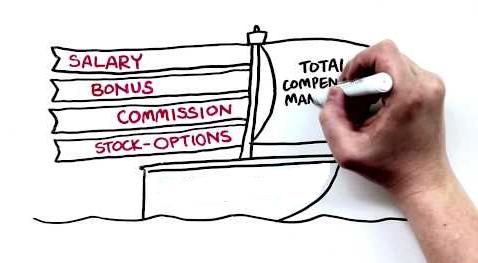In order to achieve the objectives of compensation management, it should proceed as a process. The compensation management process has various sequential steps as shown:
1. Organisation’s Strategy
Organisation’s overall strategy, though not a step of compensation management is the starting point in the total human resource management process including compensation management. Companies operating in different types of market/product having varying level of maturity, adopt different strategies and matching compensation strategy and blend of different compensation methods. Thus, it can be seen that organisations follow different strategies in different market situations and align their compensation strategy and contents with these strategies. In a growing market, an organisation can expand its business through internal expansion or takeover and merger of other organisations in the same line of business or a combination of both. In such a growing market, the inputs, particularly human resources, do not grow in the same proportion as the business expands. Therefore, in order to make the growth strategy successful, the organisation has to pay high cash to attract talents. For example, information technology is a fast growing business presently and we find maximum merger and higher managerial compensation in this industry. In mature market, the organisation does not grow through additional investment but stabilizes and the growth comes through making the present investment more effective, known as learning curve growth. In such a situation, average cash and moderate incentives may work. The benefits which have been standardized have to be maintained. In the declining market, the organisation has to harvest profit through cash generation and cost cutting and if this cannot be sustained over the long run, the possible retrenchment of business to invest somewhere else. In such a case, compensation strategy involves cost control with below average cash and incentive payments.
Cascio has observed that in viewing the compensation from strategic point of view, the companies do the following:
- They recognize remuneration as a pivotal control and incentive mechanism that can be used flexibly by the management to attain business objectives.
- They make the pay system an integral part of strategy formulation.
- They integrate pay considerations into strategic decision-making processes, such as those that involve planning and control.
- They view the company’s performance as the ultimate criterion of the success of the strategic pay decisions and operational remuneration programmes.
2. Compensation Policy
Compensation policy is derived from organisational strategy and its policy on overall human resource management. In order to make compensation management to work effectively, the organisation should clearly specify its compensation policy, which must include the basis for determining base compensation, incentives and benefits and various types of perquisites to various levels of employees. The policy should be linked with the organisational philosophy on human resources and strategy. Besides, many external factors which impinge on the policy must also be taken care of Job Analysis and Evaluation. Job analysis provides basis for defining job description and job specification with the former dealing with various characteristics and responsibilities involved in a job and the latter dealing with qualities and skills required in job performer. Job analysis also provides base for job evaluation which determines the relative worth of various jobs in the organisation. The relative worth of various jobs determines the compensation package attached with each job.
3. Analysis of Contingent Factors
Compensation plan is always formulated in the light of various factors, both external and internal, which affect the operation of human resource management system. Various external factors are conditions of human resource market, cost of living, level of economic development, social factors, pressure of trade unions and various labor laws dealing with compensation management. Various internal factors are organisation’s ability to pay and employees’ related factors such as work performance, seniority, skills, etc. These factors may be analysed through wage/salary survey.
4. Design and Implementation of Compensation Plan
After going through the above steps, the organisation may be able to design its compensation plan incorporating base compensation with provision of wage/salary increase over the period of time, various incentive plans, benefits and perquisites. Sometimes, these are determined by external party, for example, pay commissions for Government employees as well as for public sector enterprises. After designing the compensation plan, it is implemented. Implementation of compensation plan requires its communication to employees and putting this into practice.
5. Evaluation and Review
A compensation plan is not a rigid and fixed one but is dynamic since it is affected by a variety of factors which are dynamic. Therefore, compensation management should have a provision for evaluating and reviewing the compensation plan. After implementation of the plan, it will generate results either in terms of intervening variables like employee satisfaction and morale or in terms of end-result variable like increase of productivity. However, this latter variable is more important. The evaluation of compensation plan must be done in this light. If it does not work as intended, there should be review of the plan necessitating a fresh look.
